Coway Air Purifier
Coway air purifier is a favorite among Malaysians, with over seven million users. The brand has been in Malaysia for 15 years, celebrating its 15th anniversary in March 2021. Coway focuses on clean air and water, launching the Coway Experience Centre to showcase their products.
The air purifier from Coway is known for its high efficiency. It can remove up to 99.999% of ultrafine dust and 99.9% of viruses, bacteria, and mold. Its advanced filtration and energy-saving design make it perfect for keeping homes air fresh.
Introduction to Coway Air Purifier
Coway is known for quality and innovation, making their air purifier a trusted choice in Malaysia. As air purifier demand rises, understanding their features, benefits, and prices is key. This article will explore how Coway's air purifier can enhance indoor air quality.
Key Takeaways
- Over seven million Malaysians use Coway's products and services
- Coway air purifier has up to 99.999% removal efficiency for ultrafine dust
- The Coway Experience Centre showcases innovative products and services
- Coway air purifier is energy-efficient with a power consumption of 42 W
- The filtration system consists of four filters, including the Copper HEPA Filter (H13)
Understanding the Coway Air Purifier Brand
Coway is a well-known name in air purifiers, with over 30 years of innovation. It started in 1989 in South Korea and now reaches many countries, including Malaysia. In Malaysia, Coway offers a variety of air purifiers at good prices.
In Malaysia, Coway is a trusted name for air purifiers. It provides top-quality products that meet local needs. With a wide network and support, Coway helps people breathe clean air at home and work.
History and Brand Reputation
Coway has always focused on innovation and making customers happy. It's known for air purifiers that work well, look good, and are easy to use.
Global Market Presence
Now, Coway is in many countries like the USA, China, and Malaysia. This wide reach helps Coway understand different needs. It lets the brand make products for various markets.
Malaysian Market Position
In Malaysia, Coway is seen as a high-end brand. It offers air purifiers for all budgets and needs. With its good reputation and prices, Coway is a top choice for quality air purifiers in Malaysia.
How Air Purifiers Impact Indoor Air Quality
People spend about 80% of their lives indoors. This makes indoor air quality very important. A coway air purifier review can show how these devices help improve air quality. They can catch and remove 99.999% of tiny particles in the air.
Using an air purifier, like the Coway model, has many benefits. These include:
- Removing pollutants and allergens from the air
- Improving indoor air quality
- Reducing airborne contaminants
A coway air purifier review can help you choose the right one. The Coway Airmega can remove over 99.98% of SARS-CoV-2 viruses. This makes it a strong defense against airborne pathogens.
Key Features of Coway Air Purifiers
Coway air purifiers are popular in Malaysia for their innovative features. They have a multi-stage filtration system that removes up to 99.999% of particles as small as 0.01 microns. This includes dust and pollen, making them great for those with allergies or respiratory issues. The Coway air purifier harga varies based on the model and features.
Other key features include smart sensors and indicators. These detect air quality and adjust fan speed to save energy and ensure efficiency. Coway air purifiers are also energy-efficient, making them eco-friendly. Their Coway air purifier harga is competitive, making them a good value.
Multi-Stage Filtration System
The multi-stage filtration system in Coway air purifiers captures a wide range of particles. It includes a pre-filter, a HEPA filter, and an activated carbon filter. Together, they provide clean and fresh air.
Smart Sensors and Indicators
The smart sensors and indicators in Coway air purifiers detect air quality and adjust fan speed. This helps save energy and ensures the air purifier works efficiently.
Energy Efficiency Ratings
Coway air purifiers have energy efficiency ratings, making them eco-friendly. The ratings vary by model and features but aim to be energy-efficient and cost-effective.
In conclusion, Coway air purifiers are a top choice in Malaysia. They offer a multi-stage filtration system, smart sensors, and energy efficiency. The Coway air purifier harga is competitive, making them a great value for money.
Popular Coway Air Purifier Models
Coway has a variety of air purifiers to fit different needs. The Coway air purifier is well-liked for making indoor air better. Models like the Airmega and AP-1008 help keep the air clean and healthy.
Coway air purifiers are great at catching pollutants and allergens. They are also quiet and save energy. This makes them perfect for homes and offices.
Some top Coway air purifier models are:
- Airmega: It has a high CADR rating and can catch 99.999% of pollutants and allergens.
- AP-1008: It's small, energy-saving, and great for small rooms and offices.
When picking a Coway air purifier, think about the room size, air pollution, and your needs. Coway has a Coway air purifier that's just right for you.
Understanding Air Purification Technology
The air purifier coway uses a mix of technologies to clean and freshen the air. Let's explore how it works. It's designed to remove pollutants and allergens, making the air indoors better.
HEPA Filtration Explained
HEPA (High Efficiency Particulate Air) filters are key in air purifiers, like the air purifier coway. They catch 99.97% of particles over 0.3 microns, including PM10 and PM2.5. This makes them great at fighting off many airborne pollutants.
Carbon Filter Benefits
Carbon filters are also vital in air purifiers, including the air purifier coway. They tackle gases, odors, and chemicals well. This makes them a great addition to any air cleaning system.
Ionization Process
The ionization process is used in some air purifiers, like the air purifier coway. It releases negative ions into the air. These ions attract and trap pollutants, making them easier to get rid of.
Here's a quick rundown of the main technologies in the air purifier coway:
- HEPA filtration: captures 99.97% of particles over 0.3 microns
- Carbon filter: effective against gases, odors, and chemicals
- Ionization process: releases negative ions to attract and trap pollutants
Benefits of Using a Coway Air Purifier
Coway air purifiers offer clean and fresh air, making them a popular choice. They use advanced filters to remove pollutants and allergens. This improves indoor air quality and health. The coway air purifier price is also affordable, making it a great option for many.
Some key benefits of using a Coway air purifier include:
- Removal of 99.97% of viruses, bacteria, fungi, and pollen
- Trapping of dust, pollen, dander, viruses, and bacteria
- Improved indoor air quality and health benefits
- Competitive coway air purifier price
A Coway air purifier is a smart choice for better indoor air and health. Its advanced features and coway air purifier price make it a standout option.
| Feature |
Benefit |
| Advanced Filtration System |
Removes 99.97% of viruses, bacteria, fungi, and pollen |
| Competitive Price |
Affordable option for improving indoor air quality |
Installation and Maintenance Guide
Proper installation and maintenance are key for a Coway air purifier to work well. It's important to follow the manufacturer's instructions. When looking at a coway air purifier review, maintenance ease is a big factor.
A well-kept Coway air purifier can greatly improve your indoor air. Here are some tips to remember:
- Replace the deodorization filter every 6 months and the True HEPA filter every 12 months for best results.
- Clean the washable pre-filter every 2-4 weeks to keep it working well.
- Make sure to clean the air quality monitor every two months for accurate readings.
By following these easy steps and looking at a coway air purifier review, you can keep your device running smoothly. This way, it will continue to provide clean air for many years.
Coway Air Purifier Price Range in Malaysia
The prices of Coway Air Purifiers in Malaysia change based on the model and its features. They usually cost between RM 1,000 to RM 2,500. For instance, the Captain AP-1717A model is about RM 1,500. On the other hand, the Breeze AP-1018F model costs around RM 2,500.
Some well-liked models and their prices are:
- Captain AP-1717A: RM 1,500
- Breeze AP-1018F: RM 2,500
- TUBA AP-3008FH: RM 2,000
Prices can differ based on where you buy it and any special deals. It's wise to compare prices at various stores and online to get the best deal on a coway air purifier malaysia.
When picking a coway air purifier malaysia, remember to think about the cost of replacement filters and upkeep. Some models might cost more to maintain than others. So, it's key to consider this when making your choice.
Energy Consumption and Operating Costs
When you're thinking about buying a coway air purifier, remember to look at energy use and costs. The coway air purifier is made to use less energy. It uses between 57-82 watts, which is less than many other devices.
Looking at the long-term, the coway air purifier's energy use is like a laptop's. Running it for 12 hours a day costs between $2.5 and $3.5 a month. This is important if you want to save on energy and lower your bills.
Here's a comparison of energy use and costs for different air purifiers:
| Model |
CADR |
Energy Usage (watts) |
Annual Electricity Cost |
| Coway Airmega AP-1512HH |
298 CMH |
77 |
$94 |
| Levoit Core 300 |
229 CMH |
45 |
$46 |
| Colzer EPI-328 |
320 CMH |
80 |
$98 |
| Smart Air Sqair |
315 CMH |
38 |
$46 |
The table shows the coway air purifier has low energy use and costs. This makes it a good choice for saving energy and money.
Real User Experiences and Reviews
Choosing an air purifier can be tough. But, real user experiences and reviews help a lot. The Coway air purifier review shows many users like it. They say it's easy to use and makes the air cleaner.
Users love the Coway air purifier for many reasons. It catches up to 99.97% of tiny particles in the air. It's also light and affordable. Many people say it has made them feel much better, like a 90% drop in sinus pain.
Here are some key benefits of the Coway air purifier, as reported by users:
- Effective in reducing airborne particles and improving indoor air quality
- Easy to use and maintain, with a user-friendly interface and affordable replacement filters
- Lightweight and compact design, making it easy to move and place in any room
- Affordable price point, with a cost-effective replacement filter option
The Coway air purifier review from real users is very positive. Many users like its effectiveness, ease of use, and price. If you want better air or to ease allergy symptoms, the Coway air purifier is a good choice.
Comparing Coway with Other Brands
There are many air purifiers on the market. The coway air purifier is a favorite among many. It's known for removing over 99% of smoke in just 30 minutes on high setting.
The coway air purifier stands out with its special features. For example, the Coway Airmega AP-1512HH can move up to 108 CFM of air. It also has a Clean Air Delivery Rate (CADR) of 246 for dust, 240 for pollen, and 233 for smoke. This makes it great for people with allergies.
What makes the coway air purifier different? It has high performance, unique features, and is energy-efficient. The Coway Airmega AP-1512HH uses just 8.1 watts on medium setting.
In summary, the coway air purifier is a top choice. It offers great performance, special features, and saves energy. If you're looking for an air purifier for your home or office, the coway air purifier is a good option.
Health Benefits and Applications
Using a coway air purifier malaysia can make indoor air much cleaner. It removes harmful stuff like dust mites, pet dander, and VOCs. This is key in Malaysia, where indoor air can be worse than outside air, causing health problems.
Some big health wins from using a coway air purifier malaysia are:
- Less allergy symptoms and asthma attacks
- Better breathing and lung health
- Better sleep and overall feeling good
Coway air purifier malaysia models catch 99.97% of particles over 0.3 microns. This includes allergens and some bacteria. So, they're great for people in Malaysia wanting better air and health.
Getting a coway air purifier malaysia means a healthier, more comfy home. It helps lead to a happier, more productive life.
Warranty and After-Sales Support
When you buy a Coway air purifier, think about the warranty and support. A good warranty gives you peace of mind. It means you're covered if something goes wrong. Coway's warranty varies based on the product and how you bought it.
The warranty for Coway air purifiers lasts two years from when you first bought it. It covers the internal parts, except for filters. This coway air purifier review shows why knowing the warranty details is key. It helps you avoid surprise repair costs.
Here are some important points about Coway's warranty and support:
- Warranty claims must be made within thirty days of finding a defect
- It doesn't cover cosmetic damage, normal wear, unauthorized repairs, or non-genuine parts
- Replacement parts and products are covered for the rest of the original warranty or ninety days, whichever is longer
Knowing about Coway's warranty and support helps you make a smart choice. It ensures you get the best service and support for your coway air purifier review needs.
Environmental Impact and Sustainability
Coway air purifiers are made with the environment in mind. They are a top pick for those who care about sustainability. The company wants to cut greenhouse gas emissions by 50% by 2030. They've already made big steps in reducing waste and boosting energy efficiency.
The Coway Airmega air purifiers catch up to 99.97% of particles as small as 0.3 microns. This makes them a smart and green way to clean indoor air.
Here are some reasons why Coway air purifiers are good for the planet:
- They use less energy, which saves money and helps the environment.
- They're made with recycled materials.
- Their filters last a long time, cutting down on waste and the need for frequent replacements.
Choosing a Coway air purifier helps make the future greener. It also makes your home's air cleaner. Coway leads the way in eco-friendly practices and reducing emissions. They're a great choice for those who love the planet.
Conclusion: Is a Coway Air Purifier Right for You?
The Coway air purifier is a top choice for better indoor air. It uses advanced technology, smart sensors, and saves energy. This makes it great for a healthier home for you and your family.
It's perfect for tackling allergens, pollutants, and bad smells. The Coway air purifier is a versatile option for many air quality problems.
If you're looking for an air purifier in Malaysia, Coway is a great pick. It's known for quality, has a big presence worldwide, and gets good reviews. Think about what you need, how big your space is, and your budget. See how a Coway air purifier can change the air you breathe.
FAQ
What is the Coway Air Purifier?
The Coway Air Purifier is a top choice for cleaning the air indoors. It removes harmful particles, allergens, and contaminants from the air.
What are the key features of Coway Air Purifiers?
Coway Air Purifiers have a multi-stage filter system. They also come with smart sensors and indicators. Plus, they are energy-efficient, making them a great pick for many.
What are the health benefits of using a Coway Air Purifier?
Using a Coway Air Purifier can greatly improve the air you breathe indoors. This can help reduce allergies and respiratory problems by removing harmful particles from the air.
How do Coway Air Purifiers compare to other brands?
Coway Air Purifiers stand out for their quality and value. They offer a range of features that make them a favorite among consumers, beating out other brands.
What is the price range of Coway Air Purifiers in Malaysia?
In Malaysia, Coway Air Purifiers come in various models. Each model has its own set of features and price, catering to different budgets and preferences.
How do Coway Air Purifiers perform in terms of energy consumption and operating costs?
Coway Air Purifiers are built to be energy-efficient. They have low operating costs, making them a smart choice for those looking to save money and the environment.
What kind of warranty and after-sales support does Coway offer for its air purifiers?
Coway offers a solid warranty and reliable after-sales support for its air purifiers. This gives consumers confidence in the brand's quality and commitment to customer satisfaction.
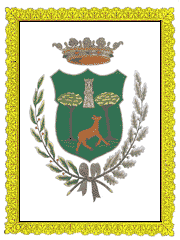 I’ve managed to collect quite a bit of information on approximately 1,000 Serracapriola immigrants to the United States. Although I used the Ellis Island website to gather this information, I couldn’t have done it without the Dr. Stephen P. Morse’s website. His site is a virtual “back door” into the vast Ellis Island database. For instance, in order to extract all of the immigrants from Serracapriola, I needed to search by the town name. The Ellis Island site does not provide this feature, but Dr. Morse’s does. For this task, I used his “gold form”; however, you can get lost for days exploring his many interesting links.
I’ve managed to collect quite a bit of information on approximately 1,000 Serracapriola immigrants to the United States. Although I used the Ellis Island website to gather this information, I couldn’t have done it without the Dr. Stephen P. Morse’s website. His site is a virtual “back door” into the vast Ellis Island database. For instance, in order to extract all of the immigrants from Serracapriola, I needed to search by the town name. The Ellis Island site does not provide this feature, but Dr. Morse’s does. For this task, I used his “gold form”; however, you can get lost for days exploring his many interesting links.
The biggest obstacle when searching for your ancestors is the many spelling errors. Whether the errors were made by the person filling out the form or transcribing the form, they can really stump you. For instance, my grandfather’s name was “Donato Miniello” but it was listed as “Donato Mintells.” I don’t know how my sister Carolyn found him! Luckily, there’s now an option to correct the misspellings in the Ellis Island database.
In addition to the misspelling of names, Serracapriola is frequently (most of the time) misspelled. In order to net as many immigrants as possible, I had to allow for these transcription errors. Here are the Serracapriola misspellings that I found:
 So if you’re not finding grandpa, be mindful of the possible misspellings.
So if you’re not finding grandpa, be mindful of the possible misspellings.
While I’m sure I haven’t managed to get all of the Serracapriola immigrants and while I’m also sure that some of my immigrants made more than one trip across the Atlantic, I think the information is nevertheless valuable and interesting from a personal as well as historical perspective. For instance, you can see from the chart below that there was virtually no immigration during World War I. My grandfather immigrated to Cleveland in 1913, but his family could not join him until 1920. Here, the personal is the political. In addition, immigration drops offs entirely when anti-Southern European sentiment in the United States virtually shuts the door and immigration stops in 1924.
If you’re having trouble locating your ancestors, use Steve Morse’s website. If you’re still unable to find them, let me know – I may have them in my database!
When They Immigrated …
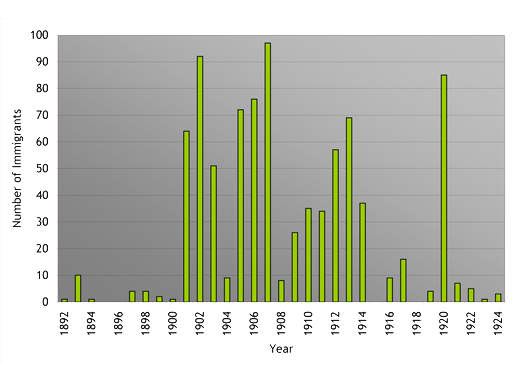 Top of Page
Top of Page
… and where they went — by state
As you can see from the pie chart below, the majority of Serracapriola immigrants went to New York and Pennsylvania. Unlike Chieuti immigrants, very few Serracapriola immigrants went to Ohio.
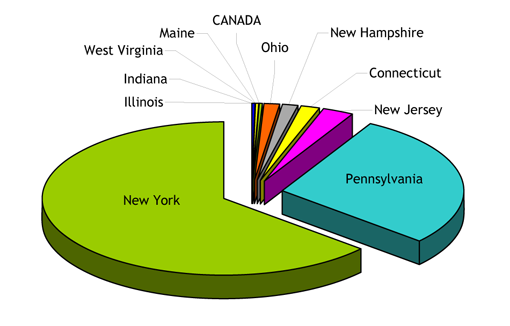
Destinations — Cities
The destination for Serracapriola immigrants is strikingly different from Chieuti immigrants. The majority of Serracapriola immigrants went to (1) New York City, (2) Pittston, and (3) White Plains. I don’t have any record of Chieuti immigrants going to White Plains. Other cities that Serracapriola immigrants went to:
- Pennsylvania: Wilkes Barre, Hillsville, Pittsburg, Scranton, Philadelphia, Chester, Hazelton, Reading
- Connecticut: Litchfield, Waterbury, Stamford, Bridgeport
- Canada: Ontario
- New York: Binghamton, Brooklyn, the Bronx, Yonkers, Staten Island, Buffalo, Queens, New Rochelle, Syracuse, Rochester
- New Jersey: Bayonne, Newark, Elizabeth, Hoboken
- Ohio: Cleveland
Age and Gender of Immigrants
Here’s one more interesting way to look at the data. Up the the age of 19, the gender of the immigrants was roughly equal. Between the ages of 20 and 49, more men than women immigrated to the U.S. After age 49, women outnumbered men, but only slightly.
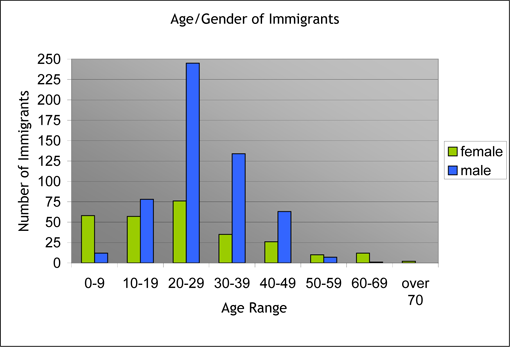 Top of Page
Top of Page
 I’ve managed to collect quite a bit of information on approximately 1,000 Serracapriola immigrants to the United States. Although I used the Ellis Island website to gather this information, I couldn’t have done it without the Dr. Stephen P. Morse’s website. His site is a virtual “back door” into the vast Ellis Island database. For instance, in order to extract all of the immigrants from Serracapriola, I needed to search by the town name. The Ellis Island site does not provide this feature, but Dr. Morse’s does. For this task, I used his “gold form”; however, you can get lost for days exploring his many interesting links.
I’ve managed to collect quite a bit of information on approximately 1,000 Serracapriola immigrants to the United States. Although I used the Ellis Island website to gather this information, I couldn’t have done it without the Dr. Stephen P. Morse’s website. His site is a virtual “back door” into the vast Ellis Island database. For instance, in order to extract all of the immigrants from Serracapriola, I needed to search by the town name. The Ellis Island site does not provide this feature, but Dr. Morse’s does. For this task, I used his “gold form”; however, you can get lost for days exploring his many interesting links. So if you’re not finding grandpa, be mindful of the possible misspellings.
So if you’re not finding grandpa, be mindful of the possible misspellings. Top of Page
Top of Page
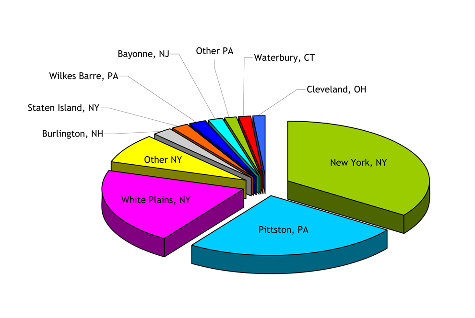 Top of Page
Top of Page